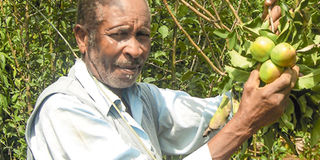Farmer makes sweet earnings from apples

Apple farmer, John Munya in his orchard in Eldoret. He began farming the fruits in 2007 soon after accompanying a friend to an apple farm in Nyeri where, out of curiosity, he bought 37 seedlings and planted them. PHOTO | LEOPOLD OBI | NMG
What you need to know:
- He started farming the fruits in 2007 soon after accompanying a friend to an apple farm in Nyeri. Out of curiosity, he bought 37 seedlings and planted them.
- In every hole, 30 kilogrammes of fully decomposed manure is mixed with the top soil and 125 grammes of single super phosphate fertiliser.
- And to get fruits with big sizes and quality, he also thins the seedlings as they grow. He adds that having a proper management schedule is key in apple farming.
- Diseases to watch out for include apple scab, a fungal disease that attacks the leaves and fruits. The symptoms include blackening and necrosis of the leaf margin. It is controlled by applying copper-based fungicides.
John Munya pulls a loosely hanging wire on his quarter-acre apple orchard in Kimumu, on the outskirts of Eldoret, and birds scamper for safety.
It is something that he does every time he spots birds on his fruit farm. The farmer has innovatively placed old metal tins in different parts of the orchard and connected them with copper wire.
Once he spots the birds, he pulls the wire, which makes the tins clunk, sending the predators away.
“This is what guarantees me my harvest because if I don’t keep the birds at bay, I won’t harvest anything,” says Munya.
He started farming the fruits in 2007 soon after accompanying a friend to an apple farm in Nyeri. Out of curiosity, he bought 37 seedlings and planted them.
Two years later, the fruits were ready for harvesting. So many were they that he had to sell the surplus. “I sold some 600 fruits at between Sh20 and Sh30, each” recalls the father of five.
This experience planted the agribusiness seed in him, with the farmer buying 30 seedlings more in 2010 at Sh250 each. His apple orchard now has over 300 trees.
“I sell the produce to traders in Eldoret, Nairobi and Kisumu. Now I get up to 100 fruits daily and sell each for Sh20,” says Munya, who has stopped growing other crops and taught himself how to graft apple seedlings.
His main picking seasons are February and August. Apple seedlings are planted in holes that are 60cm wide and 60cm deep and spaced at 3m by 3m for better growth.
In every hole, 30 kilogrammes of fully decomposed manure is mixed with the top soil and 125 grammes of single super phosphate fertiliser.
He also sells seedlings in bunches of 10 at Sh350 each, but anyone buying more than 10 seedling gets them at Sh300.
Munya grows seven varieties of apples though he notes that the green and red varieties move faster in the market.
SPROUT FROM THE BUDS
“A mature tree that is well-taken care of offers up to 3,000 pieces of apples in a year, the equivalent of 30-40 kilos,” says Munya, who has dug a borehole in his compound to irrigate the fruits during the dry seasons.
Apples require soils that are rich in potassium for the fruit’s sweetness, according to agricultural experts.
But before flowering, he has to prune all the leaves because the flowers sprout from the buds, each producing four to six fruits. Once the trees mature and start fruiting, he supports them with poles so that they don’t fall down due to the fruits’ weight.
And to get fruits with big sizes and quality, he also thins the seedlings as they grow. He adds that having a proper management schedule is key in apple farming.
“Apples require a lot of attention if they are to ever produce,” he says, adding that he can detect an infected tree or fruit by just looking at it.
Munya isolates aphids, thrips, and spiders as the major pests that attack the fruits. Birds like sparrows, woodpeckers and quivers are also a big threat but his mechanism to fight them has worked.
Diseases to watch out for include apple scab, a fungal disease that attacks the leaves and fruits. The symptoms include blackening and necrosis of the leaf margin. It is controlled by applying copper-based fungicides.
There is also leaf spot, which attacks the leaves and stem of the plant. It is also controlled by copper-based fungicides.
Powdery mildew, which affects new shoots, leaves and buds of the tree, is another disease and can be controlled by application of sulphur-based fungicide at 10-day intervals.
John Kiogora, an extension officer with Elgon Kenya Ltd, says one can improve his apple trees by coming up with a management schedule.
“To properly manage your apple trees, you need to draw a monthly or quarterly programme on how to apply manure and other inputs,” he says.
****
Climatic conditions
- Apples do well in cold conditions
- Apples, according to Kinyua (below) require cold conditions to be productive.
- They tolerate a pH range of 6.0-7.0. There are more than 7,500 apple varieties in the world but not all can grow in Kenya.
- Farmers mostly grow red and green varieties here.
In Kenya, Apples thrive well in the highland areas. The areas currently under apple production in Kenya are Kiambu, Kitale and Nandi.





